The South Omo region of Ethiopia, sometimes referred to as Omo Valley, ranks high on most any photographer’s list as a dream destination, for one main reason: an incredible density and diversity of living African tribes, all with distinct lifestyles and looks.
Though travel in the region isn’t always comfortable nor convenient, it’s still quite feasible for a visitor to see many different living tribes in a relatively short trip, all by 4×4 or minibus. For this, there’s pretty much no other place on earth at this time in history.

In the Mursi tribe of southern Ethiopia, many of the women wear clay lip plates as ornamentation. The women’s lips are cut at a age 15-16 and slowly expanded to fit larger clay plates over time. Mago National Park, South Omo, Ethiopia.
South Omo is home to tribes as follows (parenthesis indicates multiple possible spellings of tribe names): Arbore, Aari (Ari), Bena (Bana, Banna), Bodi, Bumi, Dassenech (Daasanach), Hamar (Hamer), Karo (Kara), Kwegu (Muguji), Nyangatom, Mursi, Surma (Suri), Tsemai (Tsemay, Tsamai), Turkana (this list may be incomplete – correct me if I forgot anyone!). Many visits to South Omo will also include visits to the Konso and Dorze tribes, which live just outside the South Omo region.
Some tribes are tiny, like the Karo with a population of 1,000 or the Mursi with around 7,500, while tribes like the Aari and Konso number closer to 250,000 each (these numbers according to the 2007 national census). Some of the tribes are permanently settled agro-pastoralists, whereas others are nomadic or semi-nomadic cattle herders. Each tribe lives a little differently, dresses a little differently. Some maintain animist traditions, others have adopted Christianity or Islam.
I was initially fascinated by the tribes of South Omo because of the photography of Brent Stirton, Jimmy Nelson and Eric Lafforgue, and planned a six-day visit to the region as part of a monthlong trip throughout Ethiopia in late 2015. The below are my thoughts on how to plan a first-time visit to South Omo based on my own experiences.
**pictured in featured image: ochre being applied to the hair of Karo women in the village of Kolcho.
Where and What is South Omo, and How Do I Get There?
South Omo is a zone in the Ethiopian Southern Nations, Nationalities and Peoples’ Region (SNNPR), in the deep southwest of Ethiopia. The zone is named for the Omo River, which flows south through the zone and south into Lake Turkana. South Omo had a population of around 600,000 persons as of the census of 2007. Kenya borders the South Omo to the south.
Most international trips into Ethiopia will begin with a flight into Addis Ababa’s Bole International Airport. To access South Omo zone from Addis, you can either travel south by road to the city of Arba Minch, or fly direct to Arba Minch via Ethiopian Airlines. Most trips to South Omo zone will pass through Arba Minch, including travel organized through tour operators.
(Note: drive times listed on the above Google map from Addis Ababa to Arba Minch may not be accurate.)
From Arba Minch, most trips to South Omo will continue southwest through Konso zone, and into South Omo, at which point roads fan out and provide access to various small villages as well as the small city of Jinka, which serves as the administrative capital of South Omo.
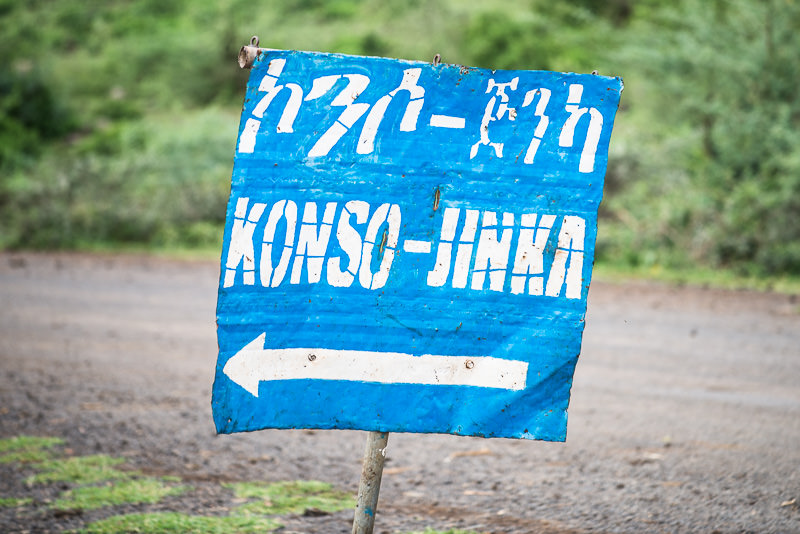
A road sign shows the way from Karat-Konso to Jinka.
Primary points of interest accessible to short-term visitors to South Omo generally include the villages of Turmi & Dimeka (Hamar tribe), Alduba (Hamar & Bena), the village of Kolcho on the banks of the Omo River (Karo tribe), Omorate in the far southwest (Dassenech tribe), Key Afer (Aari, Hamar, Bena & Tsemai), and Mago National Park (Mursi). Most routes also pass through the city of Jinka
Most visitors to South Omo will also pass through the village of Karat-Konso, which also has a bi-weekly Konso tribe market worth seeing. The Dorze tribe, which lives in a village of the same name in their woven beehive-shaped houses, are located just north of Arba Minch and can be visited as a day trip by public transport.
Note: the above list of potential destinations / points of interest is not exhaustive, and you may notice that it does not include visits to tribes like the Surma and Kwegu. I do not intend to prioritize visits to any one tribe over another – I am simply boiling down what stops most short itineraries to South Omo tend to include.
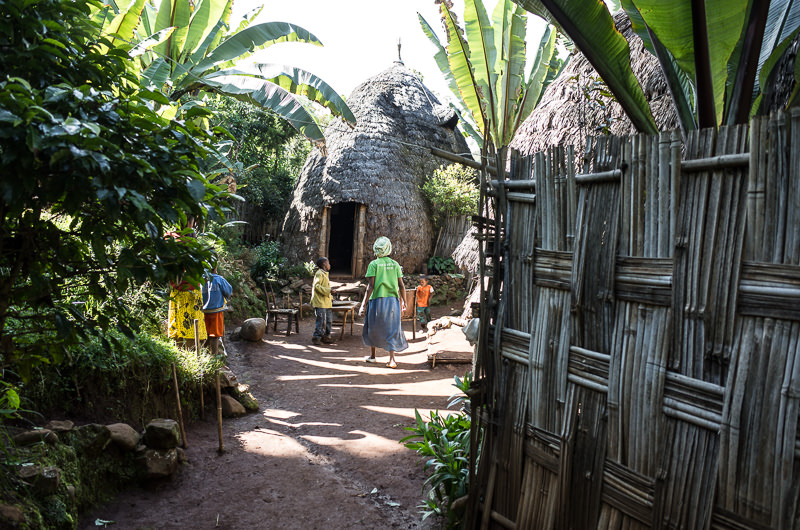
A woven beehive-shaped house in Dorze – unique to this tribe.
I would love to post a detailed map of South Omo zone, but no detailed maps really exist in the public domain. I recommend checking out the South Omo chapter of the Bradt Ethiopia guide for more information. The guide’s South Omo map is on page 536 in the September 2012 edition.
Weather Considerations in South Omo
The first thing to take into consideration when scheduling a South Omo visit is the weather. Your best bet is to visit outside of rainy season, as many of the roads to tribal villages are unpaved and ungraded, and others may pass through river beds or streams. Even just moderate rainfall can make these roads impassable.
The primary rainy season is between March and June (April and May usually being the rainiest) and makes for inadvisable traveling conditions. The “short rains” generally fall in October and can also hamper travel in South Omo. The rest of the year should be more or less fair game.
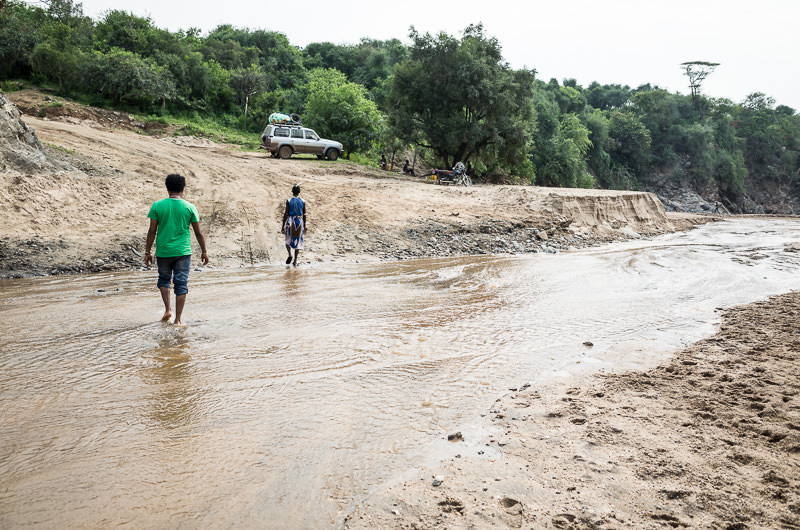
A stream crossing between Turmi and Kolcho. 4x4s can usually cross this. Minibuses will get stuck (ours in fact, did get stuck here – more on that in a subsequent post).
Transport Options in South Omo
There are three primary transport options for a visit to South Omo:
- In a hired vehicle with hired driver/guide (or driver + guide)
- Independently, without dedicated transport
- In a private vehicle (as an “overlander”)
I generally travel as cheaply as independently as I can, but in this instance, I decided to hire a vehicle, driver and guide for ease of use and so I could see as much of South Omo as possible in a limited window of time. This method of visiting Omo is what I’ll discuss below, and will not write at length on visiting South Omo without dedicated transport, nor overlanding.
Also: I don’t mean to discourage anyone from trying Omo on the cheap without a vehicle. There are trip reports like this one that state that it’s not hard to visit the South Omo independently, but I think that these travelers both did a truly fantastic job of planning/executing their schedule, and were fairly fortunate along the way to boot. Kudos to them, but this may not be convenient or comfortable for all of us.
During my South Omo trip, I met indy travelers that visited South Omo without a dedicated vehicle and found the process rather frustrating and time consuming, as well as more expensive than they had expected. If you’re thinking of hitching your way through South Omo, know that some local drivers will refuse to pick you up, and others will charge you exorbitant fees for rides between towns/villages. This can either leave you stranded in certain areas for additional time, and/or run your budget up. Either way, you’ll need to be ready to be patient, flexible and resourceful if you attempt to visit South Omo as an independent (and carry plenty of cash, as access to ATMs may be limited beyond Arba Minch and Jinka).
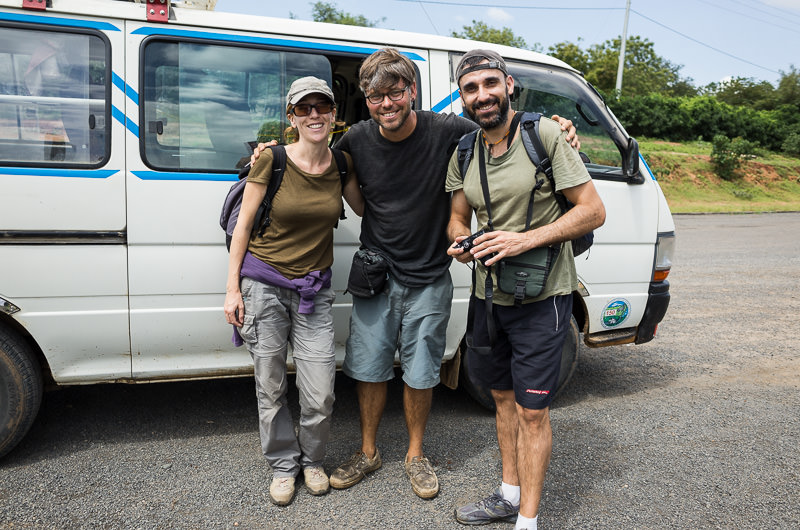
Friends from Madrid that took on South Omo as independents (and myself in the center). Also pictured: the minibus in which I rode during my time in the region.
Visiting South Omo with a Hired Vehicle
In my mind, the best way to approach a first-time visit to the South Omo is to group up with two or more travelers and contract with a guide or tour service to negotiate a schedule and fees.
If you are interested in contracting with a guide or tour company for your South Omo visit: know that the lion’s share of tour companies that run South Omo tours are located in Addis Ababa, but there are also some smaller operators located in Arba Minch as well as a few in Jinka. Tour operators in Addis will tell you that there are ZERO tour and transit operators in the south. Don’t believe the hype – I hired a guide & driver based in Arba Minch, and set out with them from Arba Minch.
Your happiness or misery on your South Omo visit will be significantly shaped by the guide / tour company you hire, so make sure to vet your guide / tour company on sites like TripAdvisor & Lonely Planet Thorn Tree, or better yet, get a current firsthand recommendation from other travelers who’ve toured Ethiopia. Talk it up. Hiring blindly may result in questionable service and experiences.
Negotiate hard with your guide / tour company, and don’t be afraid to walk away – even if walking away is just a negotiating tactic. These companies get plenty of people that walk in and pay rack rates for tours – if you make it clear that you have no plans of paying retail, the prices will likely drop to better fit your needs. Cost per passenger should be cheaper with larger groups also – make sure they are.
A few other questions worth asking when negotiating a tour price:
- What type of vehicle will you be riding in – a 4×4 or a minibus? Note that 4x4s will be more comfortable and more capable on the mostly-unpaved and often-ungraded roads of South Omo, but will likely be more expensive per day than minibus transport.
- Is our vehicle permitted to tour South Omo? (all private vehicles need a written letter of authorization to visit South Omo. These letters of authorization can be picked up at tourist offices in Addis Ababa, Jinka or Karat-Konso.)
- Is food included in the price of the tour?
- Is lodging included in the price of the tour? What are the names of a few of the hotels in question? Also, confirm single occupancy or double occupancy per your desires.
- Are village fees for events like Hamer bull jumping ceremonies, or admission to Mago National Park (where Mursi tribe lives) included, or are these additional costs?
- Are tips for local village guides included in the tour fee, or are these additional costs?
- Does the vehicle carry at least one spare tire? And will there be extra fuel on board just in case?
I hesitate to post known prices for South Omo tours here because they will likely evolve over time. My recommendation is that you contact and negotiate with multiple guides and go from there. Fair warning though: if you’re a shoestring budget backpacker, know this: on the low end of things, daily combined costs for a South Omo tour in a hired vehicle will likely amount to at least $100-200 US per day, per traveler, which I know some travelers will consider far too high to consider.
And of course, the sky’s the limit on what a given tour company will be willing to charge you if you’re willing to pay it. Tour companies with slick websites often have posted prices that are absolutely sky high and out of the question for anyone on any sort of budget. Chances are that you can negotiate better tour prices by booking in person in Addis or in Arba Minch, rather than online from your home country.
Finally: your guide and driver will expect cash tips at the end of your South Omo tour. Check prevailing rates and be ready with cash for the end of the trip.
Accommodations in South Omo
There are more or less three types of places to stay in South Omo:
- Tour company-owned lodges (upper tier of costs)
- Budget hotels (generally quite cheap)
- Camping (usually cheapest)
I personally didn’t stay at any of the tour company lodges and can’t speak to their quality or value. These definitely sound like the nicest places to stay, but come at a significantly higher cost per day than basic hotels (think $50 US plus, per night for a single).
I found the budget accommodations in South Omo very similar if not a little worse than the much of the rest of Ethiopia insofar as quality and value went. Rooms ran about $6-10 US per night. In smaller villages like Turmi and Dimeka, lodging options are quite limited and you often will “get what you get”, as opposed to what you might want. This can mean sometimes filthy shared bathrooms, rooms resembling jail cells with dirt or concrete floors and the like. So be it. If you’re a budget traveler in Ethiopia, you’re probably accustomed to (if not comfortable with) such things by now. In Jinka, which is a small city, there is a wider breadth of lodging options with a bit better quality control. Some tribal villages, as well as in Mago National Park, no paid lodgings exist whatsoever.
Camping is also an option in some areas, should you bring a tent along. Budget tours may also offer camping as a way to reduce costs as opposed to staying in lodges or cheap hotels. Many of the lodges offer campsites at reasonable rates.
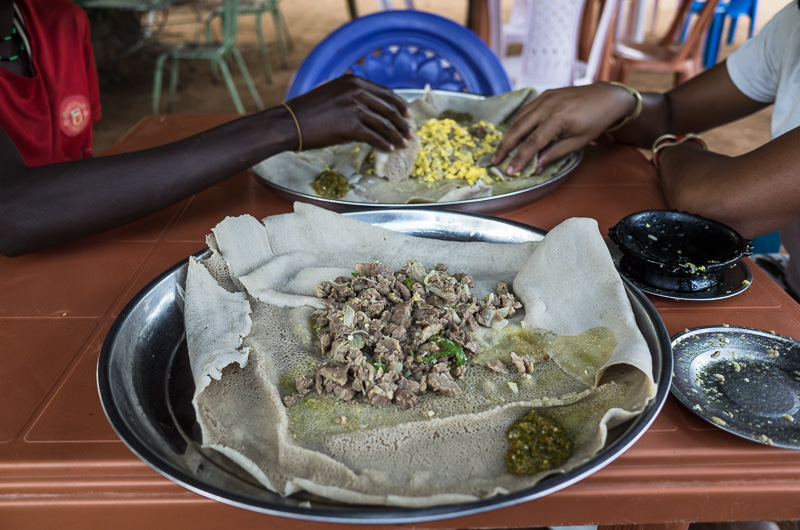
Most lodgings have some sort of restaurant attached to them. This is my breakfast of injera and goat tibs in Turmi.
Planning a South Omo Itinerary
Your tour company should be able to outline South Omo itineraries in detail, including how many hours you spend in the vehicle each day and which tribes, markets and ceremonies you will visit on each day.
The two variables that should shape every South Omo itinerary, in my mind, are tribal ceremonies (bull jumping, for example) and market days. Again, I recommend picking up a Bradt Ethiopia Guide for greater detail on such things.
The Bradt guide has great info on which tribal markets fall on which days of the week (some daily, some once or twice weekly), but will not fully detail when things like bull jumping ceremonies may take place – ask your chosen tour company if they think bull jumping ceremonies will be taking place during your trip, and try to fit one in in at all possible, because this kind of thing may be the highlight of your tour.
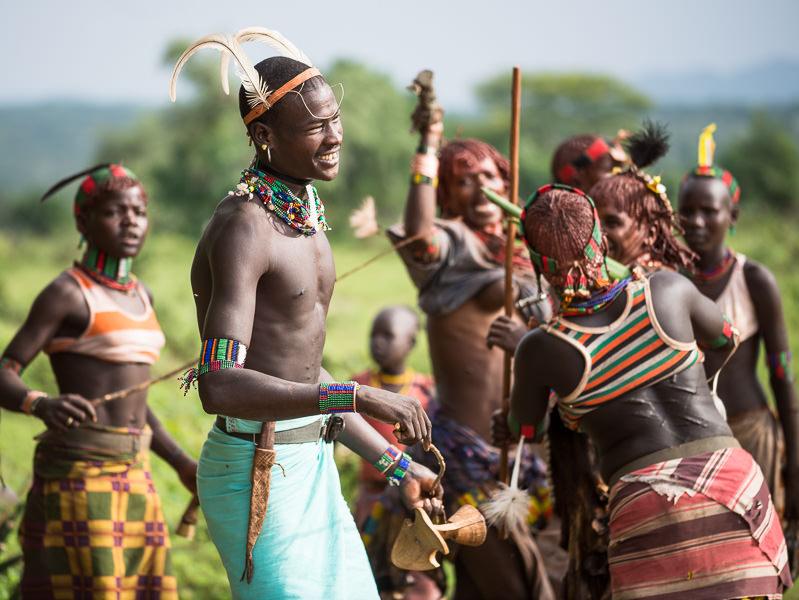
Men and women of Hamar tribe, during the beginning of a bull jumping (coming of age) ceremony. Dimeka, South Omo, Ethiopia.
Most first-time visitors will want to visit at as many tribes as possible in their allotted time – but if you’re more interested in one tribe than another, let your tour company know and adjust the plan accordingly.
I personally don’t think one tribe is more important for a first-time visitor to see than another. An undue amount of focus seems to be placed on seeing the Mursi and/or Surma considering their interesting traditions involving ornamentation of their women with lip-plates. But really, all the tribes are unique and interesting and none are worth skipping unless you’re short on time and must do so.
How many days should you set aside for a visit to South Omo? I recommend scheduling 7-10 full days (or longer) if you’re departing from Addis Ababa, as this gets you about 5-8 full days to actually see the area, bookended by two full days of transit. If you plan to depart from Arba Minch instead of Addis, you can consider pulling 1-2 days out of your Omo itinerary if time is tight.
A Few Things to Consider Before you Visit
Expectations need to be tempered significantly when visiting South Omo. This is not an “undiscovered place” nor a “last frontier”. Tourists and professional photographers both have been coming to South Omo for quite some time, and paying tribespeople to pose for photographs for so long, that many village visits are, to the tourist, a parade of village women, children and men donning traditional dress and makeup that they would only otherwise wear/apply for special ceremonies. Sometimes the garb and makeup of the tribespeople are embellished looks that have no real place in traditions other than in the tradition of being photographed by tourists. Understand that a fair amount of what you will see and photograph in South Omo is a show, put on for the cameras.
That’s not to say nothing’s real in South Omo. Things like Hamar bull jumping ceremonies are very real. Market days are very real. The traditions and toughness and self-reliance of the people here are very real. But the relationship between a tourist and the people of South Omo is a largely transactional one (paying a fee for taking photos), and not necessarily the dreamy falsehood of the “authentic travel experience”.
South Omo tribal village visits can be abrasive and sometimes awful interactions. The Mursi tribe has a particularly bad reputation for their aggressive, grabby behavior towards visitors – all because they want you to take their photo and pay them. Perhaps it’s no coincidence that an armed guard is a required hire before entering the Mursi villages. I found my Dassanech tribe village visit even more intense than my time with the Mursi, so much so that I insisted on leaving their village early. I don’t blame the locals for this – it’s tourists that showed up with cameras and money in the first place and reinforced this kind of relationship.
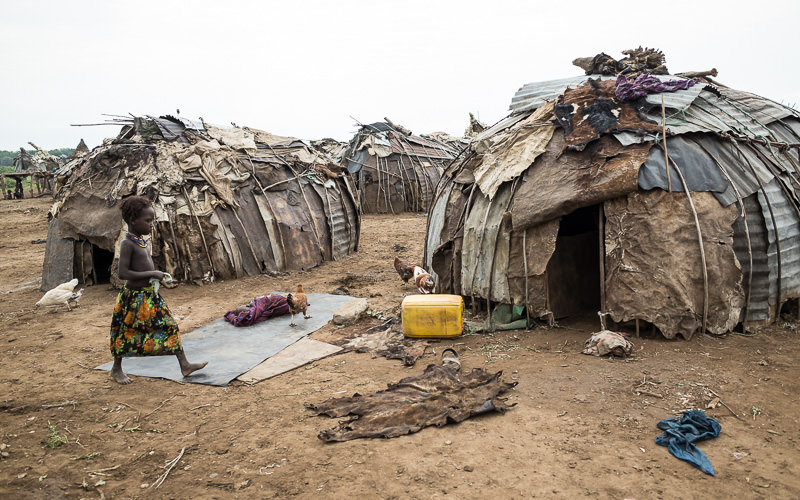
Dassenech village near Omorate. Moments after this, the whole tribe encircled me, each person loudly insisting I take their photo (for pay, of course). It was impossible to take a picture of said moment, because I would have likely had to pay each member of the tribe for such a shot.
Despite the negatives, I think South Omo is still definitely worth visiting, because there is a zero percent chance of your South Omo visit NOT being memorable and thought provoking. But the things you see and experience might not be the things you originally set out to see and experience, so be ready to be flexible.
Further reading: The Guardian – Picture story: how photographing the Omo Valley people changed their lives
Also, a visit to South Omo is not a “time machine” to a previous period in history. The things you will witness are ways of life and traditions maintained in present day, rather than relics of the past. And the present is increasingly complicated for the peoples of South Omo.
Worth knowing: in recent years, the Ethiopian government has been making large land grabs for commercial plantations in South Omo and thus has forcibly displacing tribes from their land, which has led to a reduction in land available for grazing and farming by the tribes and has accordingly stoked according inter-tribe conflicts and violence. Ethiopia’s government has also recently built a large, controversial hydroelectric dam upstream on the Omo River, which is reducing water flow of the river downstream. This threatens the tribes’ way of life from South Omo all the way to Lake Turkana in northeastern Kenya, who are reliant on the river and its seasonal flooding, for fishing and farming, respectively.
Further reading: Survival International: The Omo Valley Tribes (discussion of land appropriation, Gibe III hydroelectric dam and effects on South Omo Tribes)
My visit to South Omo left me with a lot of thoughts and questions, like these:
What is the place of these subsistence herders and/or farmers, in the age of globalization and consumerism? How long can their ways of life and languages survive in the face of these pressures? What is the quality of life for the women of a given tribe, especially those that participate in polygamy and offer limited rights to 2nd and 3rd wives? And what is the impact of sustained tourism on these communities, positive or negative?
I can’t say I have the answers to any of these questions and problems – but I think they’re things worth considering for anyone planning a visit to South Omo.
I recommend approaching your South Omo trip with an open mind, and with respect for the people whose communities you enter.
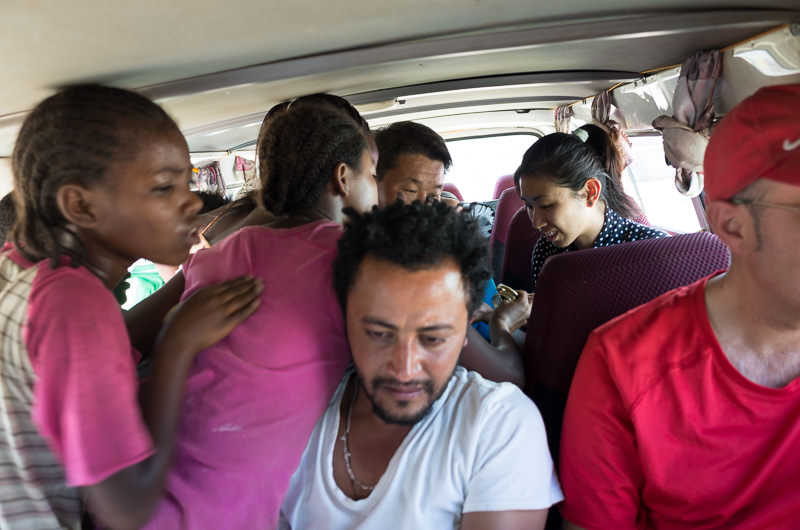
Local girls crowd into a minibus (and on top of my guide) to sell bracelets to tourists. Shot outside Karat-Konso.
My Trip to South Omo
I’ll detail my experience in South Omo in the following post. If you have any input on planning a trip to South Omo or your experiences in South Omo, don’t hesitate to comment below. Thanks!
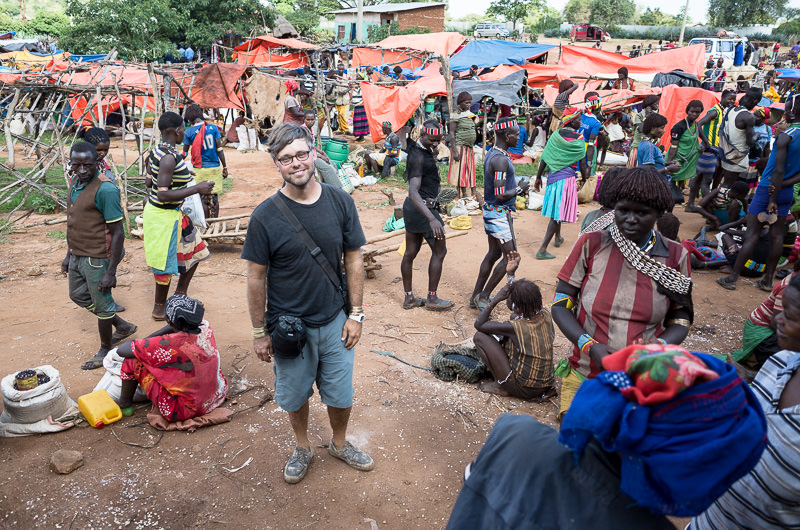
Alduba, South Omo, Ethiopia.

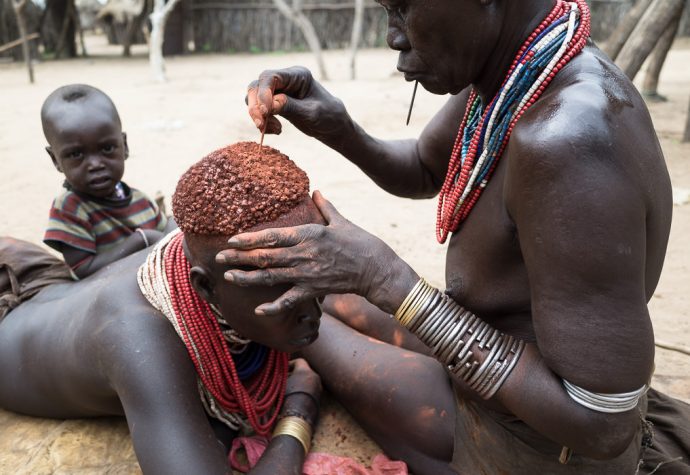
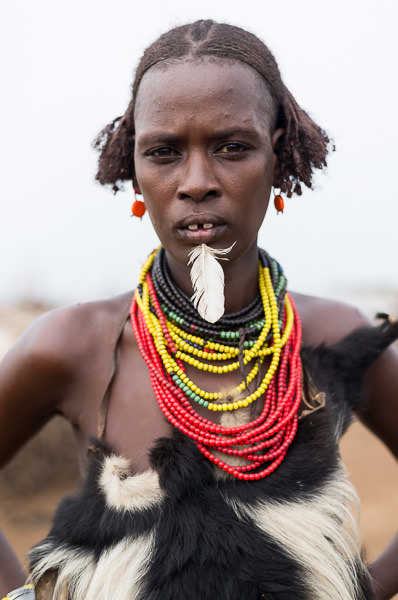

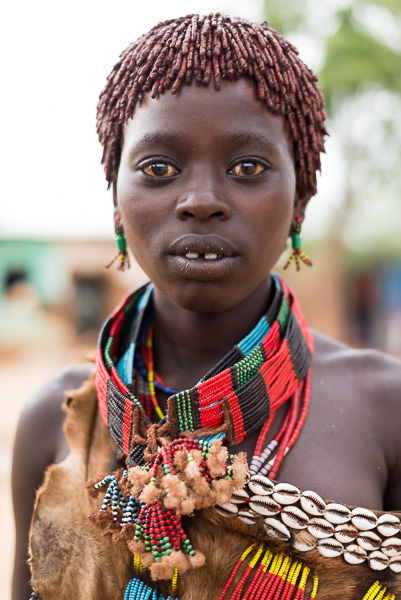
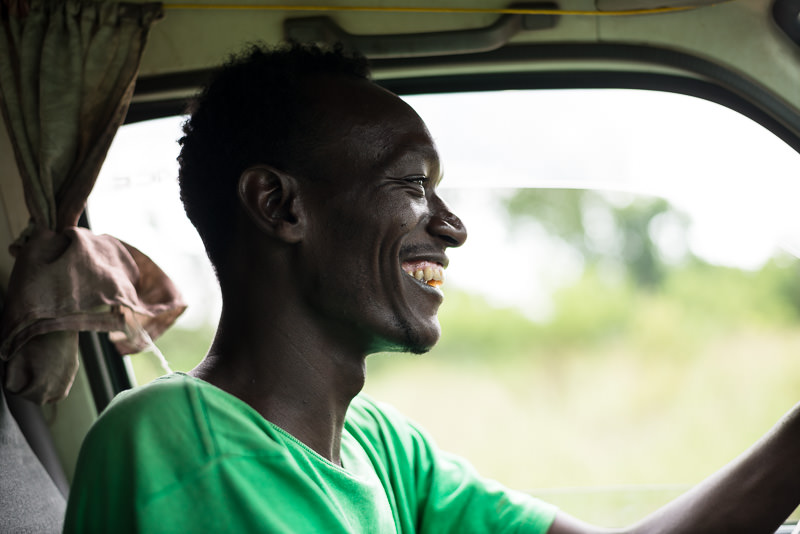
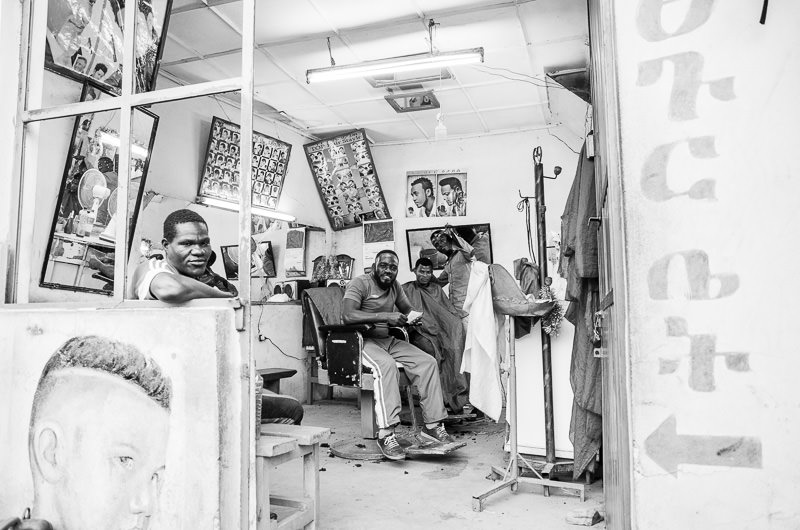
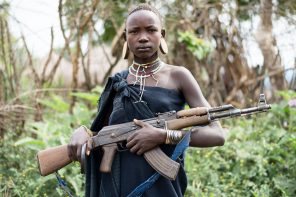
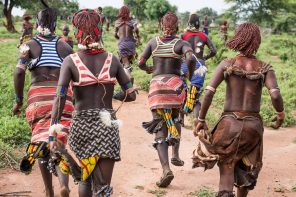
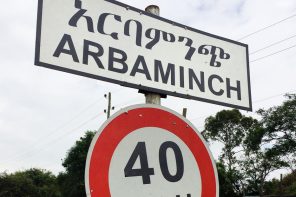
Great article, Matt! I was wondering about what time of the year you visited Omo, as the weather seems quite fine in your pictures. I’m considering a trip to Ethiopia myself around June next year. Thanks in advance!
VERY INTERESTING. Great photography. Thanks.